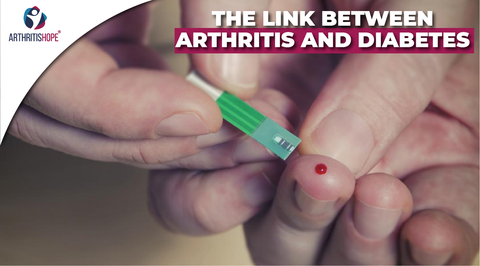
Arthritis and diabetes have a lot in common. Almost half of all adults with diabetes—47%—also have arthritis. People with arthritis have a 61% higher risk of developing diabetes than those without this joint disease.
What’s behind the link? Part of the connection stems from inflammation. Genetics and shared risk factors like obesity and inactivity are also involved.
Autoimmunity, Inflammation, and Diabetes
Autoimmune forms of arthritis like rheumatoid arthritis (RA), psoriatic arthritis (PsA), and ankylosing spondylitis (AS), as well as type 1 diabetes occur when the immune system misfires and attacks the body. In people with type 1 diabetes, the attack is against the pancreas, the organ where insulin is made. In autoimmune forms of arthritis, the joints are targeted.
Both RA and type 1 diabetes involve inflammation, and certain clinical signs of inflammation — including C-reactive protein and interleukin-6 levels — are consistently high in people with either condition.
Having one autoimmune condition can increase the risk of developing a second. This helps explain why type 1 diabetes and RA can coexist.

People with type 2 diabetes are more susceptible to developing OA. Research suggests part of the reason may be obesity and aging, which are shared risk factors for both conditions.
More recently, research has found that high blood sugar may have a direct impact on cartilage and bone health, due in part to harmful compounds called advanced glycation end products (AGEs). They form in your bloodstream when protein or fat combine with sugar. Your body naturally rids itself of the compounds, but if you have high blood sugar, you’re at a higher risk of producing too many AGEs too quickly, which can build up in the body. “The accumulation of AGEs can damage many tissues, including bone and cartilage,” says Dr. Starr. High levels of AGEs can also lead to inflammation, she adds.
Warning Signs of Diabetes

Though type 1 diabetes usually first appears during childhood or adolescence, it can also develop in adults. Type 2 diabetes is the far more common type, and can develop at any age. It occurs most often in middle-aged or older people.
Type 2 Diabetes
Signs and symptoms usually develop very slowly, over several years, and can include:
- Increased thirst and urination
- Increased hunger
- Fatigue
- Blurred vision
- Unintended weight loss
- Sores that don’t heal
Type 1 Diabetes
Signs and symptoms can happen relatively quickly, and can include:
- Increased thirst and frequent urination
- Extreme hunger
- Weakness
- Blurred vision
- Unintended weight loss
How to Reduce Your Risk of Diabetes When You Have Arthritis

There’s no way to prevent type 1 diabetes. But there are steps you can take to reduce blood sugar and lower your chances of developing type 2 diabetes, such as:
Stick to your arthritis treatment plan
Keeping your disease activity under control can help reduce inflammation in your body. Some arthritis medications have been shown to protect against diabetes. If you’re concerned about your type 2 diabetes risk (say, because of a family history or other risk factors), ask your doctor about which arthritis medications may be better for you.
Be more active
Get at least 30 minutes of physical activity, such as walking, at least five days a week. Exercise helps you control your weight and reduces blood glucose levels, as well as reduces arthritis pain and improves function. Talk to your doctor to determine which exercises are safest for you.
Shed extra pounds
If you’re overweight, losing 5 to 7 percent of your body weight can reduce your risk of diabetes. For a 200-pound person, that’s a 10- to 14-pound weight loss.
Eat healthy
Focus your diet on fruits, vegetables, whole grains, low-fat dairy, and lean sources of protein, including beans, nuts, fish, and lean cuts of meat. Control your portions to help cut calories, and choose foods that are lower in fat and higher in filling fiber.
When to see a doctor

As people age, they should see their family doctor for annual checkups. The doctor will usually order blood work to check for factors such as blood sugar levels, cholesterol, and other health warning signs.
At annual checkups, a person can ask their doctor about strategies that help prevent diabetes, especially if they have a family history of the condition.
If a person experiences any signs or symptoms of diabetes, it is best to speak to a doctor. This is because diagnosing diabetes early can help keep symptoms under control.


Leave a comment